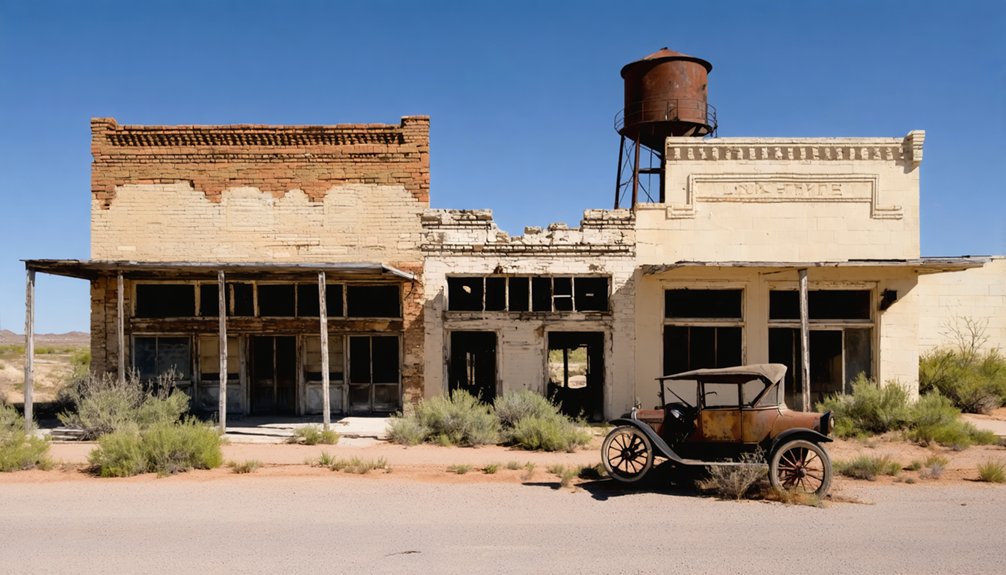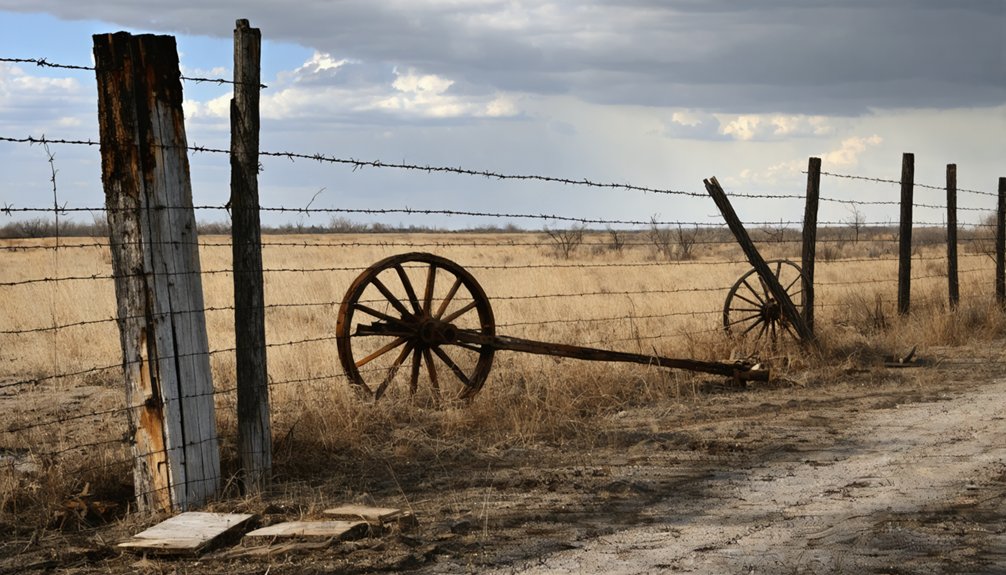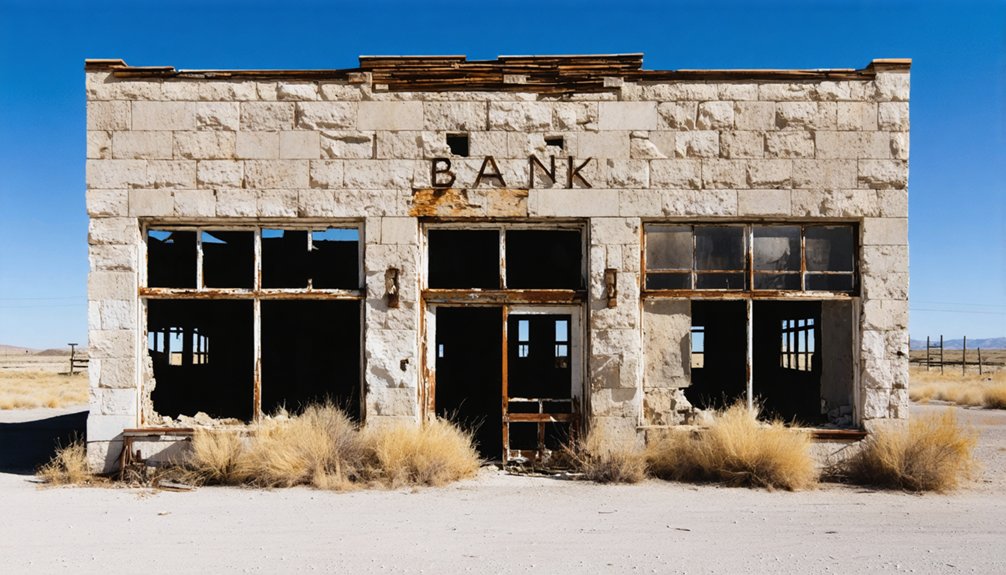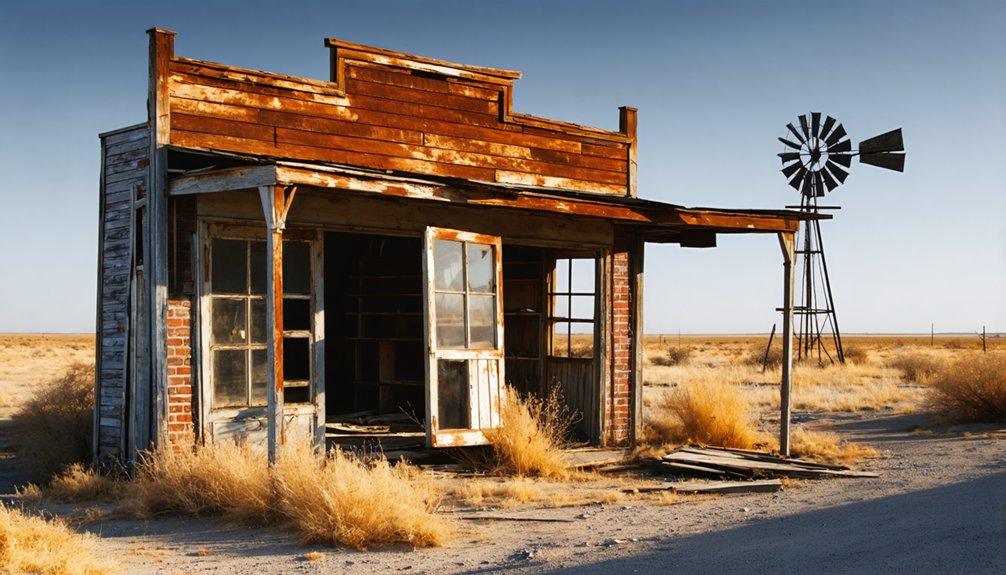You’ll find Rath City‘s ghostly remains near the Double Mountain Fork Brazos River in Texas, where Charles Rath’s buffalo hide empire once thrived. In 1876, this boomtown became the epicenter of frontier commerce, with its trading post handling over a million hides bound for Eastern markets. Hunters, gamblers, and entrepreneurs walked its streets, while saloons and dance halls buzzed with life. Boot Hill Cemetery still holds the secrets of this rough-and-tumble town’s swift rise and fall.
Key Takeaways
- Rath City was a booming buffalo-trading town established in 1876 near Double Mountain Fork Brazos River in Texas.
- During its peak in 1877-78, the town generated $1 million in business through buffalo hide trading.
- The settlement covered 200-300 acres and housed approximately 4,000 seasonal workers during its brief existence.
- The town’s decline directly correlated with the disappearance of buffalo herds by 1884, leaving only sun-bleached bones.
- Today, only Boot Hill Cemetery and archaeological artifacts remain as evidence of this once-thriving Wild West trading post.
The Buffalo Hide Empire
When Charles Rath and his business partners established Rath City in December 1876, they’d create one of the largest commercial enterprises in Texas’s buffalo hide trade.
You’d find their settlement strategically positioned near the Double Mountain Fork Brazos River, where the local bison population still roamed in abundance. The unique Rath Trail connected their operation to eastern markets, with ox-drawn wagons hauling precious hides worth up to $4 each. The town’s early development included two bustling saloons that served the growing community.
Perched along the Double Mountain Fork, Rath City’s outpost became a vital hub for bison hunters seeking frontier fortunes.
The town quickly grew to house 50-60 folks, from hunters to traders, all focused on the lucrative hide business. You’d see massive shipments heading to Fort Worth by train, with the hides destined for industrial belts back east. During the peak winter of 1877-78, the town generated an impressive million dollars in business.
The trade routes through Rath City became the lifeline of the southern plains’ hide empire.
Charles Rath’s Frontier Vision
A true frontier visionary, Charles Rath saw opportunity where others merely glimpsed empty plains. His entrepreneurial spirit transformed the Texas Panhandle through a network of trading posts and supply lines that’d change the region forever. His massive operation handled 80,000 hides during peak buffalo hunting seasons.
Rath’s foresight led him to establish strategic outposts that connected the bustling hide market of Dodge City to the untapped resources of Texas. The establishment of Fort Elliott in 1875 provided crucial military protection for his ambitious trading ventures.
- You’ll find his genius in the placement of Rath City, positioned perfectly in Stonewall County to capture the flow of buffalo hunters and their bounty.
- He built the Rath Trail, which you can trace today along U.S. 83, connecting essential trade points across the frontier.
- His Mercantile Company dominated the hide trade, creating a commercial empire that’d shape the economic destiny of the American West.
Life in a Wild West Boomtown
Life in Rath City exemplified the raw, untamed spirit of a Wild West boomtown, where you’d find an eclectic mix of buffalo hunters, gamblers, and frontier entrepreneurs packed into wooden-frame buildings atop native stone foundations.
Frontier spirits collided in Rath City, where buffalo hunters and gamblers carved out a wild existence among rough-hewn buildings.
You’d witness frontier challenges daily as roughly 4,000 seasonal workers navigated the settlement dynamics of this bustling hide-trading hub.
The town’s social epicenter revolved around its two saloons and dance hall, where you could find entertainment that’d make even the hardiest frontiersman blush.
Settlement dynamics proved harsh for women, though some ran entertainment establishments despite the hostile environment.
Through the dance hall’s doors, you’d encounter drunken brawls, shooting scrapes, and gambling, while notable figures like Pat Garrett added to the town’s rough-and-tumble reputation.
The Rise of Rath’s Trading Post
You’d have found Rath’s Trading Post serving as the epicenter of the buffalo hide trade in 1877, when its vast storage yard held over a million hides destined for Eastern markets.
The post’s strategic location near Double Mountain Fork made it a natural hub for commerce, where buffalo hunters could earn upwards of $100 daily selling their wares to Rath, Lee & Reynolds Mercantile. Between 1872 and 1874, Dodge City alone shipped nearly half a million buffalo hides.
At its height, you’d spot up to 80,000 hides stretched across the trading yard, while the store’s shelves stayed stocked with essential provisions for the steady stream of hunters passing through. The bustling outpost covered 200 to 300 acres of Stonewall County, featuring an adobe store and various amenities for workers and hunters.
Buffalo Trade Hub
During the early 1870s, Charles Rath transformed the Texas Panhandle‘s commercial landscape by establishing what’d become one of the region’s most pivotal buffalo hide trading posts.
You’ll find that Rath’s frontier trade operation dominated the buffalo economics of the region, handling upwards of 80,000 hides at peak times. The bustling commercial hub sprawled across 200-300 acres, featuring everything a buffalo hunter needed to survive and prosper. His experience managing over a million buffalo hides through his previous ventures made him uniquely qualified to run such a large operation.
At Rath City, you’d discover:
- Essential supplies like gunpowder, lead, and tobacco stocked in wooden-framed stores
- Hide yards where hunters traded their valuable buffalo skins
- Support facilities including blacksmiths, saloons, and lodging
The strategic location along the Rath Trail connected hunters directly to major markets, cementing the post’s importance in the hide trade network.
Frontier Commerce Center
When Charles Rath established his frontier trading post in December 1876, he’d transform a remote patch of Stonewall County into Texas’ most significant buffalo commerce hub.
You’d have found a bustling frontier trade center with wood-frame buildings, sod structures, and hide-covered shelters dotting the landscape near the Double Mountain Fork Brazos River.
The economic impact was staggering – over $200,000 in trade during the winter of 1877-78 alone.
You could’ve joined roughly 4,000 workers, from hide buyers to buffalo hunters, conducting business at the post. Rath’s store anchored a thriving commercial district that included saloons, a dance hall, blacksmith shop, barbershop, and restaurant-hotel.
Freight wagons regularly traversed the Rath Trail, hauling supplies in and buffalo hides out along what’s now U.S. Highway 83.
A Raw and Rugged Community

Life in Rath City offered y’all a stark glimpse into the untamed spirit of the Old West, where buffalo hunters and teamsters mingled with gamblers and ladies of the night in the town’s rough-hewn saloons.
You’d find folks livin’ in makeshift shelters fashioned from buffalo hides stretched across poles, while the more permanent residents enjoyed the offerings of the restaurant and dance hall.
If you were fixin’ to keep watch, you’d take your turn in the lookout tower, keepin’ a sharp eye out for Native American raids while law and order remained as wild as the frontier itself.
Daily Life and Entertainment
As buffalo hunters and traders descended upon Rath City in droves, they’d find themselves immersed in a community where raw entertainment ruled the day.
You’d have rubbed shoulders with an eclectic mix of characters, from Swiss counts to notorious gamblers, all drawn to the town’s wild social gatherings. The saloons and dance halls became your primary venues for escape after long days working the hide trade.
- You might’ve shared drinks with Pat Garrett or Elliott Roosevelt at one of the two bustling saloons.
- Your evenings could’ve been spent at the raucous dance hall, where transient lifestyles meant new faces nightly.
- You’d have witnessed the convergence of cowboys, hunters, and colorful characters seeking fortune in this frontier outpost.
The town’s entertainment scene reflected its untamed spirit, where freedom and fortune intertwined beneath the Texas sky.
Law and Lawlessness
During Rath City’s brief existence, you’d have witnessed a raw frontier justice system where formal law enforcement remained scarce and largely ineffective.
The town’s rugged remoteness meant you were largely on your own when it came to protecting life and property. Local resistance to organized law enforcement was common, similar to how Hill County citizens had refused to cooperate with state police. Vigilante actions and informal militia-style enforcement filled the void left by inadequate legal institutions.
You’d have encountered a volatile mix of buffalo hunters, gamblers, cowboys, and outlaws, with Pat Garrett among the notable figures passing through.
The town’s male-dominated atmosphere, fueled by drinking and gambling, sparked frequent violent disputes. When trouble erupted, justice was swift and harsh, often ending at Boot Hill cemetery.
The Texas Rangers and military maintained only a sporadic presence, leaving the townspeople to establish their own brand of frontier justice.
Notable Characters and Colorful Tales
The raw frontier spirit of Rath City attracted an eclectic mix of characters who’d shape the town’s brief but colorful history. Among the notable figures, you’d find Charles Rath himself running his mercantile empire, and Pat Garrett before he gained fame as Billy the Kid’s nemesis. Even Theodore Roosevelt’s son Elliott made an appearance in this dusty outpost.
- A mysterious Swiss Count and political refugee added international intrigue to the local scene.
- Transient entertainers, including gamblers and dancers, kept the saloons lively.
- Cowboys and teamsters formed the backbone of daily life, living rough in tents and dugouts.
You’d witness a fascinating parade of humanity in Rath City – from buffalo hunters nursing their wounds to outlaws seeking refuge, each adding their own chapter to this frontier settlement’s legendary tale.
The Great Buffalo Hunt

From humble beginnings along the railroad lines, Rath City emerged as a critical outpost in one of history’s most devastating wildlife massacres – the Great Buffalo Hunt of the 1870s and 1880s.
You’d have witnessed professional hunters tracking massive buffalo migration patterns across the Texas plains, armed with powerful long-range rifles that could drop hundreds of beasts daily. These skilled marksmen employed ruthless hunting techniques, positioning themselves downwind and targeting herd leaders first. Native hunters like the Sioux demonstrated greater restraint, taking only what was needed for essential resources including meat, robes, and sinews.
The railroad made it mighty profitable, with buffalo hides fetching up to $2.00 apiece in eastern markets. The first commercial hunt in Texas marked the beginning of widespread buffalo hunting operations across the state.
While Native Americans had long conducted sustainable hunts for sustenance and ceremony, commercial hunting decimated the herds. By 1884, you’d have found nothing but sun-bleached bones scattered across the prairie, later collected for fertilizer – a grim reminder of the hunt’s devastating toll.
Boot Hill and Beyond
You’ll find Buffalo hunters laid to rest in Rath City’s Boot Hill Cemetery, where rough justice and sudden death marked many a grave across its sprawling hilltop acres.
Their weathered markers tell tales of gunfights, accidents, and disease that claimed folks who “died with their boots on” during the wild days of the buffalo trade.
The cemetery’s concrete-covered plots and unmarked sites bear witness to the region’s frontier law system, where disputes were often settled with six-shooters rather than courtroom gavels.
Graves of Buffalo Hunters
Located beneath a modern wheat field near the Brazos River, Boot Hill cemetery stands as a haunting memorial to the buffalo hunters who met violent ends at Rath City.
You’ll find evidence of frontier burial practices in the native rock walls surrounding each grave, with Tom Lumpkin’s final resting place marked by particularly higher stonework.
These stark reminders of frontier mortality tell tales of men who died with their boots on.
- “Spotted Jack” and other hunters lie beneath wooden headboards, victims of Comanche attacks and frontier violence.
- Marshall Sewall’s tragic death by torture and scalping represents the brutal reality faced by hide men.
- Boot Hill’s graves, now preserved through archaeological study, showcase the dangerous lives of those who pursued buffalo across the Texas plains.
Wild West Justice System
As lawlessness gripped the Texas frontier, justice at Rath City balanced precariously between formal legal structures and vigilante enforcement.
You’d find sheriffs stretched thin, wrestling with multiple roles while lacking the resources to maintain order across vast territories. When official law proved ineffective, local “committees of safety” took matters into their own hands, targeting rustlers and murderers through swift, often brutal action.
Legal hangings drew thousands of spectators, turning frontier justice into public spectacle. You might’ve witnessed families gathering to watch these grim proceedings, which served as stark warnings to would-be outlaws.
Meanwhile, ranchers established their own codes of conduct, creating informal but effective systems of justice. These private laws helped maintain order when official enforcement couldn’t reach the remote corners of Texas range country.
The Town’s Swift Decline

During its short existence, Rath City experienced one of the most dramatic economic collapses in Texas frontier history.
You’d have witnessed the town’s swift demise between 1878 and 1880, when the massive wildlife depletion of buffalo herds destroyed the settlement’s only economic foundation.
The town’s downfall followed this brutal progression:
- Buffalo hunters couldn’t find enough game to sustain their trade by spring 1878
- Merchants and traders abandoned their shops as demand for supplies vanished
- The remaining townsfolk fled by 1880, leaving behind only stone foundations and buffalo hunters’ graves
What you’ll find today at Rath City’s location is mostly wheat fields, with just a few crumbling remnants visible after harvest – a stark reminder of how quickly a frontier boom town could go bust when its single resource disappeared.
Archaeological Discoveries
Recent archaeological excavations have transformed our understanding of Rath City’s brief but significant frontier period.
Modern excavation methods beneath wheat fields have unearthed foundations of native stone buildings, trading posts, and essential frontier businesses. You’ll find evidence of the town’s bustling commercial life through artifacts from saloons, a blacksmith shop, and the renowned Rath store.
Archaeological techniques have revealed the stark realities of frontier life at Boot Hill, where graves of buffalo hunters like Spotted Jack and Tom Lumpkin remind you of the settlement’s dangerous nature.
The dig sites have yielded a treasure trove of buffalo trade artifacts – hide-stretching poles, lead bars, and trading goods – painting a vivid picture of a once-thriving hide market that processed over a million buffalo hides at its peak.
Frequently Asked Questions
How Did Women Survive Daily Life in Rath City’s Harsh Environment?
You’d survive through hard-earned daily routines – cookin’, cleanin’, and workin’ in saloons or boardin’ houses. Your survival skills meant bartering services, forming protective alliances, and adapting to lawless frontier conditions.
What Happened to Charles Rath After the Town’s Abandonment?
You’ll find Charles Rath’s fate took him to Fort Worth, where he kept running mercantile operations and freight businesses. He’d shifted from buffalo trading to broader commercial ventures across Texas and Kansas.
Were There Any Children Living in Rath City?
You won’t find any childhood memories or ghost stories about kids in Rath City – historical records and archaeological digs show it was purely an adult trading post focused on buffalo hunters and saloons.
What Native American Tribes Interacted With Rath City’s Inhabitants?
Ever wonder about those frontier encounters? You’d have seen Comanche, Kiowa, and Southern Cheyenne tribes near Rath City, though tribal interactions were mostly hostile with few peaceful cultural exchanges happening directly in town.
How Did Residents Get Their Drinking Water in This Frontier Settlement?
You’d get your water straight from the Double Mountain Fork Brazos River and a nearby creek, or buy it by the bucket from the saloon’s cistern, facing typical frontier challenges of supply.
References
- https://en.wikipedia.org/wiki/Rath_City
- https://www.lubbockonline.com/story/lifestyle/2016/01/24/caprock-chronicles-rath-city-was-trade-center-bison-hunters/14923669007/
- https://fordcountyhistory.org/the-rath-trail/chapter-18-where-the-rath-trail-led/
- https://www.legendsofamerica.com/we-charlesrath/
- https://kids.kiddle.co/Rath_City
- https://atlas.thc.texas.gov/Details?fn=print&atlasnumber=5433004203
- https://www.ghosttowns.com/states/tx/rathcity.html
- https://www.tshaonline.org/handbook/entries/rath-charles
- https://worldfamousgunfighters.weebly.com/charles-rath.html
- http://www.kansashistory.us/charlesrath.html



